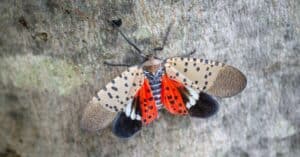The spotted lanternfly (Lycorma delicatula) is an unwanted visitor in the United States. It is a native species of eastern Asia and feeds by sucking sap from plants. These creatures were first found in Berks County, Pennsylvania in 2014 and have been spreading in Maryland since October 2018. A quarantine order is in place in several parts of Maryland including in Montgomery where this clip was filmed. The footage shows an ingenious teenager who has constructed her lanternfly trap to remove them from a maple tree that she likes to climb. She managed to catch 1,200 of them in two traps in just a fortnight. Scroll down to see the full extraordinary clip of this genius teen and her science competition entry.
Why Are Spotted Lanternflies a Problem?
Firstly, spotted lantern flies do not fly at all! They are plant hoppers and belong to the Hemiptera order. This makes them a relative of aphids and cicadas. In the juvenile stage, they can hop around but in the adult stage, they can use their wings to fly short distances. These guys are mainly being spread around by humans. We unknowingly move eggs over long distances when they are attached to plants, firewood, and construction and shipping materials. They can also be spread around by vehicles.
They are a problem because they have the potential to alter the ecosystems and agricultural production where they are found. Even though they would prefer to feed on exotic tree species, they will also feed on native plants. They suck out the plant sap from young leaves and stems using their piercing and sucking mouth parts. This causes damage and attracts other insects which promotes mold growth. The main threat is to agriculture.

The
spotted lanternfly
is an invasive species in the US.
©iStock.com/arlutz73
How to Trap Lanternflies
Lanternflies have a fairly distinctive appearance so you should be able to spot if you have them on trees near you. They look very like a moth when their wings are open and are about an inch long. The wings are gray to red and have black spots. The rear wings have a distinctive splash of bright red.
Most lanternfly traps target them as they are climbing up the tree trunks from the ground. One option is to place a sticky band horizontally around the tree trunk. However, this can also capture native insects and even small reptiles and birds. An alternative is a circle weevil trap which consists of a tunnel of insect screening leading to a dead end.
Just like this enterprising teen, you can make your lanternfly circle trap using simple items that you already have around your home. Here are the instructions. Good luck!
Watch the Impressive Footage Below
The photo featured at the top of this post is © iStock.com/arlutz73
Thank you for reading! Have some feedback for us? Contact the AZ Animals editorial team.







